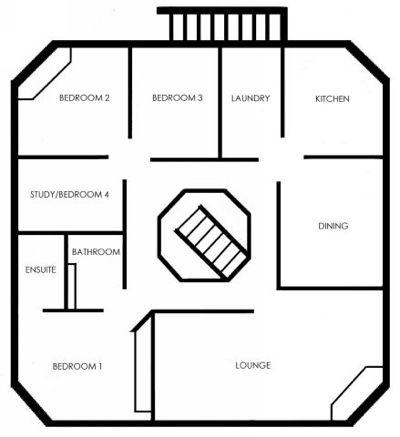204 Monaro Crescent, Red Hill (1963)
The house at 204 Monaro Crescent, Red Hill, was designed by Robin Boyd for Will Graves Verge in 1963 and completed in 1964.
It is one of five that Boyd built in Canberra and was the first for the new firm, Romberg and Boyd, following the acrimonious departure of Roy Grounds from the original tripartite partnership. Romberg and Boyd continued in partnership until Boyd’s untimely death in 1971 at the age of 52.
In 1962, W G Verge had published a book on the work of the leading colonial architect, John Verge, of whom he was the grandson. Boyd was a devotee of early colonial architecture who regarded Verge’s Camden Park (1832-35) as Australia’s most eminent house and Elizabeth Bay House (1835-37) as a masterpiece. The latter’s oval saloon with its cantilevered staircase leading to a gallery capped by a domed ceiling with lantern-like windows was, Boyd said,
the most famous architectural detail in the country.
So he gave W G Verge a modern link to his forebear by designing an octagonal double storey entry hall with central staircase leading to a gallery which connected to all main rooms, topped by an octagonal skylight which flooded the area with light.
Apart from J R Conner’s A Guide to Canberra Buildings, there appears to be no mention of the house in any reference book (including Boyd’s 1970 residential portfolio, Living in Australia).

204 Monaro Crescent floorplan
Description
The three-bedroom plus study, two-bathroom house is of grey-brown Besser brick construction with internal limed timber walls and timber floors. Entry is through the ground-level double carports that form an enclosed, heavily shaded portico. The main stairway is positioned obliquely to the front door so as to rise toward the east corner of the main living level of the house.
All rooms are arranged around the two-storey, octagonal central atrium and main stair landing. The dining room, music room and sitting room (which includes an interlocking brick fireplace) are located on the eastern and southern side of the house, enclosed by floor-to-ceiling glass walls on the interior and exterior. The bedrooms at the rear quarters are linked by the same central landing.
The octagonal concept, essentially a square with the edges snipped off, is carried through to the exterior with eight pillars of crenellated concrete block providing the main supports. The house is flanked by wide timber-lined eaves which are shaved back at the four corner pillars.
The house is open both to the exterior and, through the glass interior walls, to itself. Good views from the house to Parliament House and the city are available from the living rooms and kitchen, although now partially obscured by trees and neighbouring houses.
The house presents in near original condition. There have been no substantial renovations, alterations or additions since it was first occupied.
This profile was written by Tim Reeves, co-author of 100 Canberra Houses.
Source
- Geoffrey Serle, Robin Boyd: A Life, MUP, 1995
- Will Graves Verge, John Verge, early Australian architect: His ledger & his clients, Wentworth, 1962

